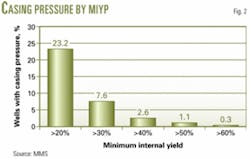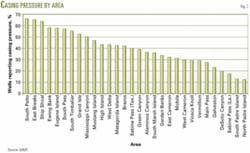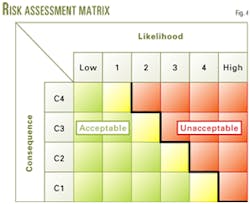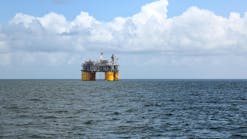A new API recommended practice (RP) intends to provide a guide for managing annular casing pressure in offshore wells.
An August workshop in Houston reviewed the draft proposal and solicited input from the attendees. American Petroleum Institute (API), US Minerals Management Service (MMS), and the Offshore Operators Committee (OOC) organized the workshop.
API expects balloting on the new RP to take place in the first-quarter 2005.
Impetus for RP
The industry undertook this work as a result of the May 18, 2003, MMS notice to lessees and operators (NTL No. 2003-P072003) that requires all annuli in a well to be monitored for sustained casing pressure (SCP), per Federal Regulation 30 CFR 250.517(c). The NTL defined SCP as any measurable annular pressure at the casinghead that:
- Will rebuild to essentially the original annular pressure after being bled down.
- Is attributable to causes other than an artificially applied annular pressure (such as gas lift) that remains isolated from all other annuli or temperature fluctuations in the well.
The regulations required continual monitoring of all casing pressures with gauges and notifying the MMS if SCP was detected. The NTL stated that the MMS district supervisor would determine the appropriate action to be taken on a case-by-case base.
The industry found these rules too prescriptive and inadequate in addressing the complexity of subsea or hybrid systems that have become more prevalent in the Gulf of Mexico as development has progressed into deeper water.
Hybrid completions are wells drilled with a subsea wellhead and completed with a surface casinghead, tubinghead, tubing hanger, and tree. These wells typically are on a floating platform such as a spar or tension leg platform (TLP). Fig. 1 shows the basic components of three types of wellheads found in the gulf.
One main problem with the NTL was that it conflicted with API 17D requirements that prohibited penetrations of the subsea wellhead. The lack of penetrations inhibits monitoring of all casing pressures except in the tubing-production casing annulus. The basic fears are that penetrations through a wellhead could lead to a U-tube effect during drilling and that small diameter penetrations could plug and cause misleading pressure readings.
The API and industry has worked closely with MMS on the new RP and hope that MMS will adopt the RP in its regulations concerning sustained casing pressure.
SCP problem
At the workshop, Don Howard, MMS Gulf of Mexico regional supervisor for field operations, said that "During the 1980s four serious accidents occurred apparently as a result of high SCP. In response, the MMS developed numerous policies for the Gulf of Mexico outer continental shelf to ensure effective monitoring of the SCP of wells in an attempt to avoid future accidents." He indicated that 6,650 active wells out of a total 14,927 wells have reported SCP. Some of the statistics he presented were:
- 52% of the wells have SCP on the production casing.
- The SCP in more than 75% of the wells is less than 20% minimum internal yield pressure (MIYP) of the affected casing.
- About 0.3% of the wells have an SCP greater than 60% of MIYP (Fig. 2), but these may be caused by small leaks that readily bleed to zero pressure.
- Three areas in the gulf have more than 60% of the wells with SCP (Fig. 3).
He said MMS has estimated conservatively that eliminating this pressure in all wells would cost $650 million and be impractical. Therefore, MMS is seeking to identify only those wells in which SCP may represent a hazard.
Draft proposal
The draft says the proposed RP will not address the prevention of annular casing pressure or the remediation of wells due to sustained casing pressure, but both issues will be covered in API RP 65, Parts 2 and 3. The proposed RP will cover both thermal pressure and sustained casing pressure and provide a guide for monitoring, diagnostic testing, risk assessment, and documentation of annular casing pressure for offshore-completed wells.
As currently written, this RP includes a risk-based approach that an operator can use to develop an appropriate annular casing management program. It also covers diagnostic tests for finding the cause of the pressure.
Included are bleed down and buildup tests, evaluation of fluids and volumes from bleed-down tests, evaluation of real-time accessible pressure data, production logs, operational observations, etc.
The proposed SCP risk model includes a decision tree to filter out non-problem wells and introduces that calculation of a maximum allowable wellhead operating pressure (MAWOP) that would replace the MIYP criteria for determining the severity of the pressure problem. The risk evaluation combines both the probability and the consequences of the loss of containment and considers all potential barrier failure modes (Fig. 4).
The RP draft indicates that not all annulus pressure represents a significant increase in risk and that the pressure magnitude is not an indication of leak size. Also, an increase in the pressure does not indicate that the leak size is increasing. It also says that annulus pressure bleed off should be minimized because it will gradually displace the annular fluid and aggravates the leak. The proposed MAWOP is the maximum operating pressure for a particular annulus, measured at the wellhead relative to ambient pressure, that will ensure two independent pressure containing barriers.
The draft indicates that the MAWOP in annulus N would be calculated at all depths by the minimum of:
- A% of minimum collapse pressure of annulus N inner tubular.
- B% of minimum internal yield pressure of annulus N outer tubular.
- C% of minimum internal yield pressure of annulus N+1 outer tubular.
- D% of fracture gradient pressure at the shoe of annulus N.
- N = Annulus (A, B, C annulus, etc.), annulus N+1 is the next annulus out.
- A = 75%, use 60% for internally cold expanded API pipe.
- B = 67%, use 50% for the last pressure containing casing (nonstructural).
- C = 80% if the N+1 annulus is monitored or 67% if not.
- D = 90%, not applicable if the cement is brought back up past the shoe.




